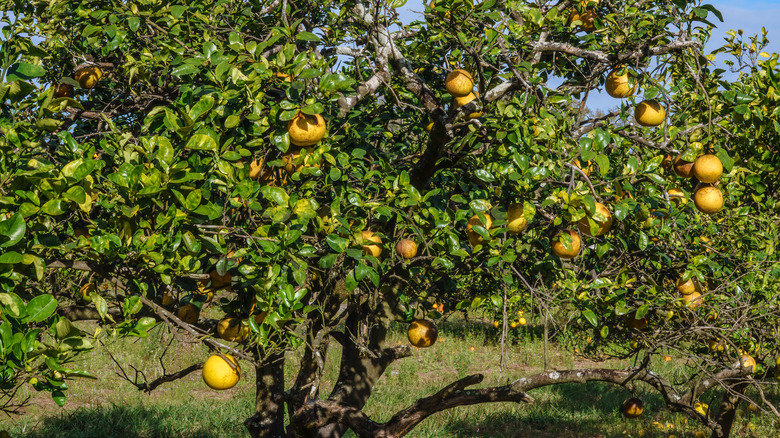How Grapefruit Was First Introduced To The US
Second only to oranges as a beloved breakfast fruit, grapefruits yield a bunch– both in terms of how they grow and their nutrients. A powerful detoxifier, they pack a vitamin C punch, providing 64% of the necessary daily intake from only one fruit, according to Healthline. Their sour, slightly bitter, and sweet flavor makes for an underrated salad addition or a nutritious boost for a healthy tonic. Yet grapefruits' origins is somewhat of a mystery. Unlike most citrus fruit, which originated in Southeast Asia (via Nature), grapefruit is believed to have emerged in Barbados, per Britannica.
Their biology explains their indeterminate creation. Most likely, the large citrus was born after an English captain brought pummelo seeds to the West Indies, via Art Culinaire. While growing next to a sweet orange tree, hybridization ensued, and the grapefruit was born, per Texas A&M. Such chance cross-breeding is typical for citrus (via Home Citrus Growers), and while not all endure, the grapefruit stuck around. Its rise to popularity globally was largely mirrored by its introduction to North America. So let's slice into how it was first introduced to the U.S.
Odet Philippe, a pioneer in Central Florida, introduced grapefruit to the U.S in 1823
According to the American Society for Horticultural Science, before grapefruit appeared on American shores in 1823, its cultivation flourished in Mexico for several decades. Yet by 1889, grapefruit comprised 6-7% of Florida's citrus exports (although it remained relatively unknown to consumers at the time). Such a flux of commercialization is accredited to two men. A Frenchman named Odet Philippe first planted the fruit on a new homestead near present-day St. Petersburg. Seventy years later, an immigrant from the north named Kimball Chase Atwood burned down a forest and planted 16,000 grapefruit trees. A few decades later, his plantation became the world's leading producer of the large citrus, per Atlas Obscura.
Through the 20th century, grapefruit's growth spread to Arizona, California, and, most prominently, the Rio Grande Valley in Texas. By the late-1960s, the U.S. constituted 70% of the global crop production, states the journal, Fruits of Warm Climates. New fruit mutations, such as the pink and ruby red, occurred, and the grapefruit of today's grocery stores is different than the first commercialized variety, per The Nibble. The fruit isn't going away and for a good reason — it's delicious and adaptable, like when elevated with a broil for breakfast.

